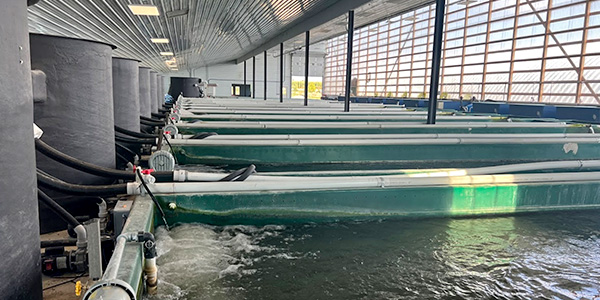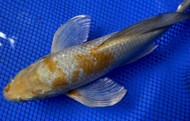Ochiba Koi: The 'Fallen Leaf' Variety Sweeps Autumn-Themed Ponds
Posted by Kloubec Koi Farm on 14th Oct 2025
The Ochiba Koi, a stunning variety developed in the mid-1990s, perfectly captures the essence of falling autumn leaves in aquatic form. These graceful fish showcase a mesmerizing blend of silver-gray or tea-colored base tones adorned with orange and brown patterns, creating a living tribute to autumn's splendor. Bred from Chagoi and Soragoi lineages, Ochiba Koi require specific conditions to thrive, including proper pond depth, filtered water, and careful seasonal maintenance. Their unique appearance stems from specialized breeding techniques emphasizing clean pattern edges and balanced color distribution. The voyage of finding these extraordinary fish's care and characteristics reveals an even more fascinating story.
Origins of the Autumn Koi
Among the diverse varieties of koi fish, the Ochiba emerged as a distinct breed in the mid-1990s through the selective breeding of Chagoi and Soragoi koi.
While this variety is relatively new, its ancient origins can be traced back to the original common carp, which has inhabited Earth's waters for over 20 million years.
The progression from common carp to the stunning Ochiba koi that we recognize today is a reflection of human ingenuity and patience.
The story begins in China, where carp were first domesticated as a food source in the 5th century BCE.
When these fish made their way to Japan in the 1st century CE, they found a special home in the rice paddies of Niigata Prefecture.
It wasn't until the 1820s that Japanese farmers began noticing and cultivating natural color mutations, laying the groundwork for Japanese folklore to accept these fish as symbols of perseverance and beauty.
The development of the Ochiba variety, with its distinctive grey or brown base adorned with orange patterns reminiscent of autumn leaves floating on water, represents the continuing evolution of koi breeding.
This relatively young variety carries forward the rich heritage of centuries of selective breeding while adding its own chapter to the story of ornamental koi.
Today, premier breeders like Kloubec Koi Farm continue to refine and perfect the Ochiba variety alongside other classic koi types bred on their koi farm in Amana, Iowa.
Captivating Colors and Patterns
The distinctive appearance of Ochiba Koi fascinates collectors and enthusiasts worldwide with its extraordinary combination of colors and patterns.
These graceful fish showcase a silver-gray or tea-colored brown base, improved by an intricate network of scale outlines called fukurin, which creates a mesmerizing reticulated appearance. Like fallen autumn leaves floating on water, their brown or copper patterns drift across their bodies in perfect harmony.
What makes Ochiba Koi truly exceptional is their balanced color combinations and pattern symmetry. The most sought-after specimens display sharp, clean edges between colors, with no bleeding or blurring where patterns meet.
Whether sporting a Tancho mark, Maruten spot, or the dramatic lightning-like Inazuma pattern, these fish command attention with their autumn-inspired aesthetic. The darker maroon variations are particularly prized among collectors for their distinctive look.
Both fully scaled and Doitsu varieties maintain these cherished characteristics, though each offers its own unique appeal.
When selecting an Ochiba Koi, look for consistent coloring throughout the body and well-balanced patterns that create a pleasing visual flow, much like nature's own artistic arrangement of fallen leaves.
Selecting Premium Ochiba Specimens
Selecting premium Ochiba Koi requires a keen understanding of their distinctive qualities and evaluation criteria. The trait evaluation process focuses on several key aspects, including balanced color distribution between the orenji (orange) and cha (brown) elements, as well as the quality of the reticulation pattern that gives these fish their characteristic fallen leaf appearance.
When executing a premium selection, experts look for an even spread of the orenji pattern across the fish's body, complemented by well-defined fukurin (scale borders) that create an appealing net-like effect. The face pattern should ideally follow traditional kohaku styling, while the body must display proper conformation and proportions.
Curiously, young Ochiba can undergo significant changes as they mature, making the selection process something of an art form that requires considerable experience.
Quality specimens often come from established bloodlines, though this isn't a guarantee of excellence. A helpful tip for enthusiasts is to look for scales with deep, consistent coloring and no visible defects.
Creating Perfect Pond Environments
Creating an ideal pond environment for Ochiba Koi involves carefully considering multiple essential factors, from basic structural requirements to sophisticated life-support systems.
When planning your pond dimensions, start with a minimum depth of 3 feet and an 8×8 feet surface area. Remember, though, that bigger is usually better for koi ponds!
To maintain optimal water conditions, install both mechanical and biological filtration systems, and remember proper oxygenation through air stones or waterfalls. Regular testing of water parameters, especially pH levels between 7.0 and 7.8, is vital for your Ochiba's health. A well-designed bottom drain will help maintain circulation and oxygen levels throughout the pond.
Environmental protection is equally important. Position your pond away from uphill slopes to prevent chemical runoff, and incorporate strategic shading while still allowing 5-6 hours of sunlight daily.
Add region-appropriate plants like water lilies for aesthetic appeal and to provide natural shelter for your Ochiba Koi and help maintain the pond's ecological balance.
Seasonal Care and Maintenance
Successful Ochiba Koi care requires distinct maintenance routines throughout the year, as each season presents unique challenges and requirements. Monitoring water temperature is vital, as it directly affects feeding patterns and overall fish health. When temperatures rise above 50°F in spring, careful observation for stress signs becomes necessary while gradually reintroducing food.
Key seasonal responsibilities include:
- Spring cleanup and system restart, including filter maintenance and gradual feeding resumption
- Summer heat management through proper aeration and shade provision
- Fall preparation with reduced feeding and installation of protective netting
- Winter care focusing on minimal disturbance and ice prevention
During warmer months, maintaining ideal water quality becomes more challenging due to increased biological activity. Regular water testing and efficient filtration help prevent potential health issues.
As autumn approaches, switching to wheat germ-based foods aids digestion as metabolism slows.
Winter presents unique challenges, requiring careful attention to ice formation and depth maintenance. Remember that stress signs, such as erratic swimming or loss of appetite, can indicate seasonal adjustment difficulties, making consistent monitoring essential for maintaining healthy Ochiba Koi throughout the year.
Growth and Development Stages
Ochiba Koi undergo distinct developmental phases throughout their lifespan, with each stage characterized by specific growth patterns and requirements.
In their first year, these extraordinary fish display impressive growth rates, often reaching six inches by their first birthday. During this significant period, proper feeding habits focused on protein-rich diets help establish strong bone structure and ideal development.
The juvenile stage, lasting through the second year, sees continued rapid growth as Ochiba can stretch to 15 inches in length. This period demands careful attention to dietary diversity, including nutritious treats like shrimp and krill.
By age five, well-maintained Ochiba often reach around 26 inches, though exceptional specimens may grow even larger.
Environmental factors play an essential role in achieving maximum growth potential. A spacious pond environment of at least 3 feet deep and 5,000 gallons provides the swimming space necessary for healthy development.
Regular monitoring of water parameters, combined with consistent temperature control and appropriate feeding schedules, helps guarantee these graceful fish reach their full potential while maintaining their distinctive "fallen leaf" appearance.
Breeding Success Stories
Throughout the years, notable breeding achievements have emerged from pairing Chagoi with various koi varieties, particularly Kohaku, to produce exceptional Ochiba specimens. These breeding techniques have evolved substantially, leading to remarkable success stories in creating the distinctive "fallen leaf" patterns that collectors admire.
Several key achievements stand out in Ochiba breeding history:
- The pioneering revelation that Chagoi and Soragoi pairings could consistently produce the signature Ochiba Shigure pattern.
- The successful introduction of Kohaku genetics, which transformed pattern development and market appeal.
- The expertise in tank spawning methods, resulting in higher survival rates and better quality control.
- The development of specialized culling techniques that improved pattern consistency.
Despite genetic variability challenges, dedicated breeders have perfected their methods through careful selection and patience.
One particularly remarkable success came when breeders found that Chagoi x Kohaku pairings could produce offspring with stronger colors and more defined dorsal-oriented patterns. This innovation has become the gold standard in modern Ochiba breeding, demonstrating how persistent enhancement of breeding practices can lead to extraordinary results.
Show Quality Standards
The evaluation of show-quality Ochiba Koi centers on four primary criteria: base coloration, pattern development, scale characteristics, and body conformation.
In koi competitions, judges scrutinize the silver-gray base color, which should evoke the serene image of autumn pond water. The bronze or gold markings must create a striking yet harmonious contrast against this backdrop, mimicking fallen leaves floating on the pond surface.
Scale reticulation plays an essential role in pattern evaluation, with each scale requiring precise outlining to create that distinctive net-like appearance. However, partially or completely scaleless Doitsu variations are judged on their pattern quality alone.
The body should display strong health and proper proportions, demonstrating the breed's characteristic potential for impressive size.
Ochiba Koi have gained significant recognition in shows in recent years, moving beyond their traditional Kawarimono classification. New variations, including the sparkling Ginrin Ochiba and metallic Doitsu Ochiba, have expanded judging categories.
Successful show specimens typically feature multiple pattern steps, clean edges (kiwa), and that unmistakable autumn-leaf essence that makes this unique variety so enchanting.
Conclusion
What could be more enchanting than watching ochiba koi glide through autumn-tinted waters, their scales reflecting the same golden hues as falling leaves above? These extraordinary fish have transformed ornamental pond keeping, combining the timeless appeal of traditional koi with nature's most striking fall colors. Through careful breeding, ideal environmental conditions, and dedicated maintenance, ochiba koi continue to fascinate enthusiasts worldwide, setting new standards for both show competitions and backyard pond aesthetics.
Shop our selection of Ochiba koi, shipped next day air to your door!
www.kloubeckoi.com/ochiba-koi-for-sale


